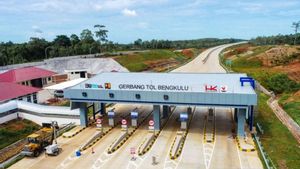JAKARTA - The Ministry of Public Works and Public Housing (PUPR) is collaborating with the Meteorology, Climatology and Geophysics Agency (BMKG) and a number of related agencies to carry out Weather Modification Technology (TMC) on June 1-5, 2024.
The TMC operation was intended to fill 43 dams on the island of Java, which experienced a decrease in capacity due to El Nino.
Director of Operations and Maintenance of the Directorate General of Water Resources of the Ministry of PUPR, Adek Rizaldi, said the volume of dam storage in Java was reduced by around 19 percent due to El Nino, which was 981.5 million cubic meters of water.
"One of the most worrying impacts of this decrease in water volume is the reduction in water supply for irrigation, which in turn will reduce the area of land that can be irrigated during the planting season," he said in a statement, Saturday, June 8.
Therefore, the Ministry of PUPR carried out TMC operations in the hope of overcoming the capacity volume deficit and ensuring the availability of water during planting period II, so that farmers can still harvest and irrigation service plans for the planting period III can be increased.
Adek said the implementation of TMC was divided into three posts, namely post 2 in Bandung for 8 dams, post 3 in Solo for 23 dams and post 4 in Malang for 12 dams.
"The TMC activity has been carried out since June 1-5, 2024 with the result of rain at around 22 Dams from the target of 43 Dams," he said.
A total of 22 dams include the Jatiluhur Dam, Kedung Ombo, Wadaslintang, Logung, Gembong, Sanggeh, Cipancuh and Bolang.
Then, at the Badukuwung Dam, Panohan, Grawang, Randugunting, Gunung Rowo, Gondang Lamongan and Prijetan. Furthermore, at Telaga Ngebel Dam, Rancabereum, Malayu, Lodan, Cacaban, 'Wonorejo and 'Pacal'.
The stages of implementing TMC include BMKG providing information on predictions of potential clouds in Java Island that have the potential to cause rain. Then, the Directorate General of Water Resources identified a dam that requires additional water.
BRIN analyzed the need for seeding materials and planned flights. Then, the Indonesian Air Force carried out cloud seeding. After the seeding, BMKG and BRIN monitored the results and the rain.
After that, the Directorate General of Natural Resources then monitors rainfall, reservoir water level, reservoir volume, inflow and outflow for 24 hours and analyzes additional water and potential services with the latest effective volume.
Finally, an evaluation of the implementation of TMC every day is carried out. The above stages are carried out repeatedly until the TMC is declared complete.
The English, Chinese, Japanese, Arabic, and French versions are automatically generated by the AI. So there may still be inaccuracies in translating, please always see Indonesian as our main language. (system supported by DigitalSiber.id)













